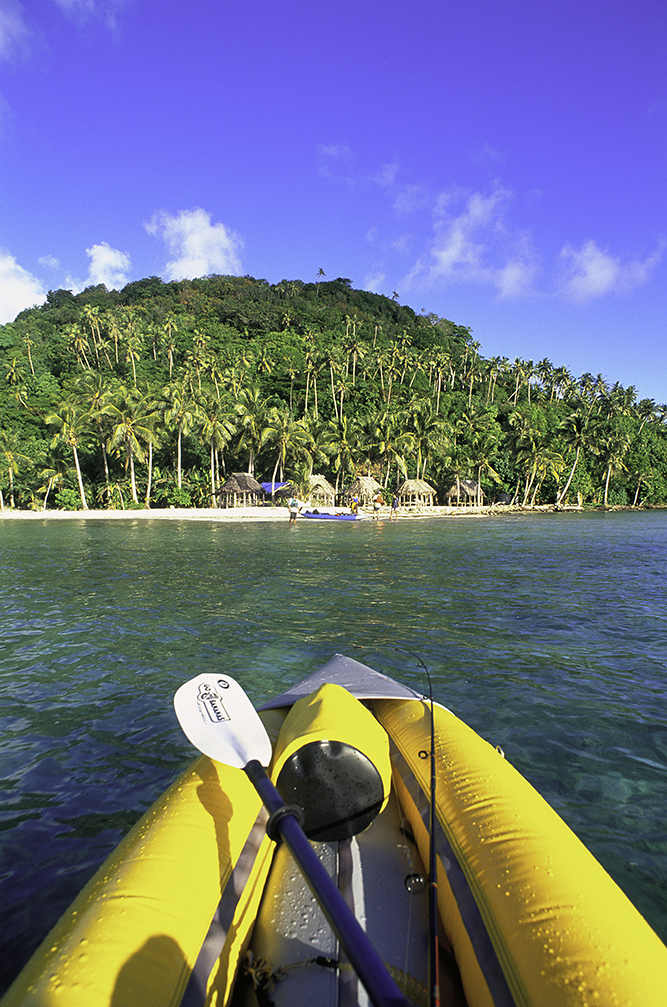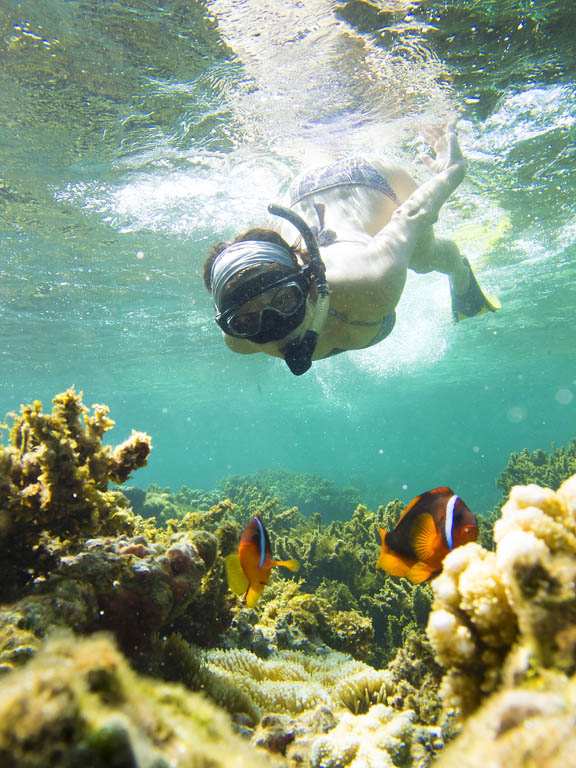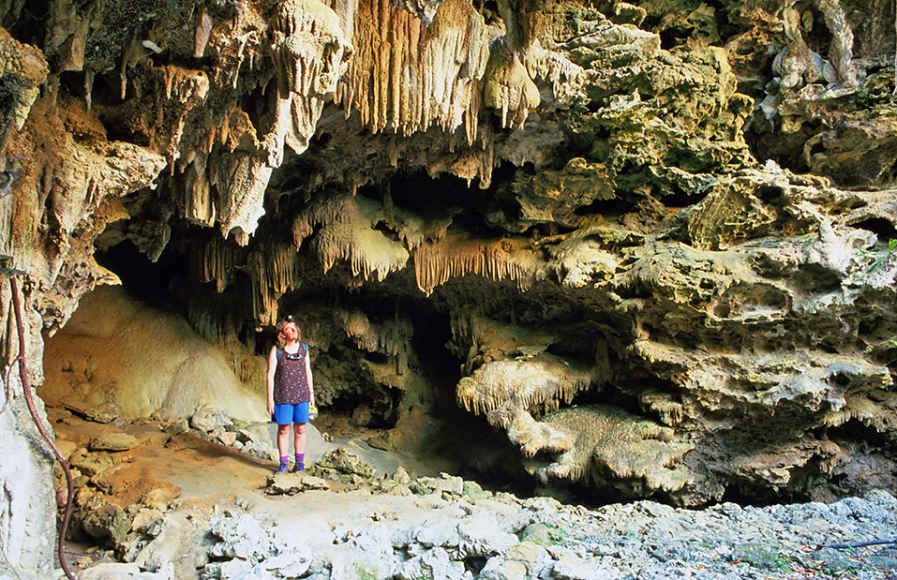Plan Your Trip
Outdoor Adventures
Plenty of people come to the South Pacific in search of low-key R&R, but if you're feeling active there's plenty to keep you busy here too, both on/in the water and on dry land. Give it some thought before you go.
Top Island Activities
Rarotonga & the Cook Islands
Rarotonga Water sports, hiking, exploring, fishing, diving
Aitutaki Water sports in and around the lagoon, diving
‘Atiu Cave explorations, birdwatching
Suwarrow Yachting, birdwatching, exploring the national park
Samoa
‘Upolu Hiking, water sports, fishing, slipping down waterfalls at the Sliding Rocks
Savai’i Hiking, exploring waterfalls and lava overflows, diving
American Samoa
Tutuila Water sports, sea kayaking, hiking, exploring the marine sanctuary and national park
Manu’a Islands Swimming at Ofu Beach, hiking
Tonga
Tongatapu Cave exploring, sea kayaking, surfing
‘Eua Hiking, birdwatching, diving
Ha’apai Sea kayaking, water sports, diving, kitesurfing
Vava’u Sea kayaking, fishing, water sports, sailing, diving
Activities
On the Water
Millions of square kilometres of warm tropical sea, picture-perfect lagoons and long swathes of beach are the most obvious attractions for travellers in this part of the South Pacific. Almost everyone comes to this region to get wet – diving, snorkelling, surfing, swimming, sea kayaking and sailing all have their devotees, and the fishing is among the world’s best.
Boat Trips
We’re talking day trips on a boat here – not plush, month-long cruises on a liner. There are all sorts of options throughout the islands, from glass-bottomed boats peering down on marine life to day tours on small boats, big boats, yachts and catamarans. Many will offer stops along the way for swimming and snorkelling, bushwalking, fishing or beach barbecues. Make sure you know what’s included (lunch?), check if there's a toilet aboard, then head out for the day and enjoy. Don’t forget your sunglasses, hat and sunscreen.
A lagoon cruise is a must if you’re visiting Aitutaki in the Cook Islands, as is a day sailing if you’re in Vava’u, Tonga.
Diving
This neck of the South Pacific is as much a Garden of Eden below the waterline as it is on land. No doubt you’ll impress your friends when you get home with stories of awesome walls, high-voltage drift dives, close encounters with sharks and manta rays, luscious soft and hard corals, shipwrecks and gorgeous reefs replete with multihued tropical fish. Visibility is mostly excellent, waters are warm year-round and most dive centres are first rate. Each island has its own underwater personality and distinctive assets, conspiring to create a seemingly endless diving repertoire.
Diving is possible year-round, although conditions vary according to the season and location. Visibility can be reduced in the wet season as the water is muddied by sediments, and areas exposed to currents might also become heavy with particles. On average, visibility ranges from 15m to 50m.
Though it’s possible to dive without a wetsuit, most divers wear at least a Lycra outsuit to protect themselves from abrasions. A 3mm tropical wetsuit is entirely appropriate.
In most places you’ll find professional and reliable dive centres staffed with qualified instructors catering to divers of all levels. The majority of dive centres are affiliated with an internationally recognised diving organisation – eg PADI, SSI, NAUI and CMAS. They are mostly hotel based, but they do welcome walk-ins. It’s a good idea to visit the centre before you sign up, to get the feel of the operation. Most places have websites: do some homework before you go.
Dive centres are open year-round, most of them every day – but it’s best to reserve your dive at least a day in advance. Depending on the area, centres typically offer two-tank dives (usually in the morning) or single dives (one in the morning and one in the afternoon). Many sites are offshore and involve a boat ride.
Diving in the South Pacific is expensive in comparison to most destinations in Asia, the Caribbean or the Red Sea. Set dive packages (eg five or 10 dives) are usually cheaper. Gear hire may or may not be included in the price, so it’s not a bad idea to bring your own equipment if you're planning to do a lot of diving.
If you’re a certified diver, don’t forget to bring your C-card and logbook with you. Dive centres welcome divers regardless of their training background, provided they can produce a certificate from an internationally recognised agency.
DIVING & FLYING
Most divers travelling to these South Pacific countries get here by plane. While it’s fine to dive soon after flying, it’s important to remember that your last dive should be completed at least 12 hours (some experts advise 24 hours) before your next flight to minimise the risk of residual nitrogen in the blood, which can cause decompression injury. As so much inter-island transportation is by air, careful attention to flight times is necessary.
DIVING FOR THE FIRST TIME
These warm Polynesian waters with their prolific marine life provide ideal and safe conditions for beginners. Arrange an introductory dive with a dive centre to give you a feel for what life is like when you can breathe underwater.
Your training will begin on dry land, where the instructor will run you through basic safety procedures and show you the equipment. Under the guidance of the instructor, your first dive will take place in a safe location (sometimes a swimming pool) and will usually last between 20 and 40 minutes. You’ll practise breathing with the regulator above the surface before going underwater. Then the instructor will hold your hand if necessary and guide your movements at a depth of between 3m and 10m.
There is no formal procedure, but you shouldn’t dive if you have a medical condition (including acute ear, nose and throat problems); epilepsy or heart disease (such as infarction); if you have a cold or sinusitis; or if you are pregnant.
If you enjoy your introductory dive, you might want to follow a four- to five-day course to get first-level PADI (Professional Association of Diving Instructors) certification. This will allow you to dive anywhere in the world – it’s like a driving licence (minus the 'r').
Fishing
For many anglers the South Pacific is a dream destination, with super local fishing and even better big-game ocean fishing. Common catches include yellowfin and skipjack tuna, wahoo, barracuda, sailfish, and blue, black and striped marlin.
Deep-sea fishing charters are available throughout the islands. If you're feeling sporting, the Samoa International Game Fishing Tournament in April draws a crowd, or there's the Tongan International Billfish Tournament every September in Vava’u (billfish are marlin).
Kitesurfing
Kitesurfing or kiteboarding has a growing legion of fans, and Rarotonga and Aitutaki provide a couple of great options. Aitutaki even hosts an international kitesurfing contest in late June. In Tonga, you can kitesurf on Uoleva in the Ha'apai Group.
Sailing
Sailing through the South Pacific is a dream come true for yachties. Every year during the May-to-October dry season, hundreds of trans-Pacific yachts harness the east-to-west trade winds and cross the central South Pacific, checking out some of the most remote islands on the globe. The yachties are usually gone by the end of October as the November-to-April cyclone season approaches.
Never fear, however, if you don’t have your own boat, as hitch-hiking across the Pacific is not out of the question…especially if you’ve got a bit of experience. Many yachts are looking for extra crew. Check noticeboards at yacht clubs and yachting hotspots such as Vava’u in Tonga. Vava’u’s picturesque Port of Refuge is one of the planet's best safe anchorages.
Chartering a yacht is also an option, especially if there is a group of you: once again, Vava’u is the place to go. There are 61 gorgeous islands with spectacular turquoise waterways to explore here. Keep in mind that you’ll need to have enough experience to meet the charter company’s requirements and that it won’t let you head out of Vava’u or further afield.
But even if you don't have any experience, you can still go sailing here. Take a day cruise on a yacht or catamaran, learn to sail in Rarotonga’s Muri Lagoon, rent out a small sailboat or play around on a windsurfer.
Sea Kayaking
Almost every island resort or visitor destination in the region will have kayaks or canoes for guests to use. These will range from simple family float-arounds to sophisticated high-tech sea kayaks designed for multiday adventures. The former are generally free for guests, or rentable by the hour, half-day or day. The latter are usually for use on guided tours.
For those who are keen to head out on an adventuresome guided paddle, there is a growing number of options, from half-day paddles to 11-day whoppers. Tonga is the place to go, with myriad islands, lagoons and stretches of sheltered water. There's a day-trip kayak operator on Tongatapu, with longer trips available in the Ha'apai and Vava'u island groups.

Surfing
Polynesians invented surfing, with the first recorded observations of boardriding made in Hawai’i and Tahiti in the 1770s. Nevertheless, surfing in most Pacific islands is still in its infancy. Increasingly, however, surfers are seeking uncrowded waves in Rarotonga, Samoa and Tonga. There aren't many easy-going beach breaks here: surfers need to be intermediate at least, and should always talk to a local before hitting the water. Waves break outside coral lagoon reefs, so the paddle out can be long and enervating – and these reefs can be very unforgiving if you get that take-off wrong. Also, few islands have surfboards for sale, so surfers must come equipped – but surfing virgin waves in these warm, vodka-clear waters is an incredible experience.
CORAL ATOLLS
The central South Pacific has two types of island: ‘high’ ones that are mostly the peaks of volcanoes, extinct or active; and ‘low’ ones, aka atolls, that are formed by coral growth on sunken submarine volcanoes.
Basically, the ocean floor has many submerged volcanoes. Some rise above the sea’s surface to become islands, and corals begin to grow around the edges. If subsequent tectonic-plate movement causes the volcano to sink, the coral continues to grow in order to stay close to the sunlight. As the central island sinks, a fringing lagoon forms between the island and the reef. A coral atoll is formed when the island finally sinks completely, leaving a ring of coral encircling an empty lagoon. Charles Darwin was the first person to recognise this phenomenon.
The long conversion of these coral islets to inhabitable islands begins when coral sitting above the sea’s surface is broken up by waves, eventually forming a coarse, infertile soil. Seeds blown along by the wind, carried by the sea or redistributed by bird droppings can then take root. Initially, only the most hardy of plants, such as coconut palms, can survive in this barren environment. Once the pioneering coconuts have established a foothold, rotting vegetative matter forms a more hospitable soil for other plants.
The people of the South Pacific have learned how to eke out an existence from even the most modest of coral atolls. Vegetables brought from other islands, such as taro and kumara (sweet potato), supplement what grows naturally, and fish from the sea and the lagoon provide protein. Atoll populations, however, live a precarious existence, as resources are scarce and the atolls are vulnerable to droughts, storms, tsunamis and rising sea levels.
Swimming & Snorkelling
Everyone loves to splash around in warm tropical water, of which there is no shortage in these central South Pacific countries. To enrich the experience, there's so much underwater marine life to look at here that you (and especially your kids) won’t want to come to the surface. A mask, a snorkel and a pair of flippers may be all you need to make your visit entirely memorable.
If you take your snorkelling seriously, BYO gear, especially if you’re heading out to somewhere remote. If you’re going to a tourism hotspot and snorkelling is just something you want to try, you should be able to rent equipment or buy it cheap locally. Resorts often have snorkelling gear available free for guests to use.

Whale Watching
Migrating humpback whales head to these central South Pacific waters for the southern-hemisphere winter, generally arriving in June and staying through to October. They give birth in shallow, warm waters around island groups, with myriad whale-watching tours there to bear witness, especially in Rarotonga and Tonga.
These tours attract considerable controversy, opponents suggesting that operators disrupt breeding cycles and exploit these creatures when they're at their most vulnerable.
TROPICAL CYCLONE WATCH
In the Atlantic they call them ‘hurricanes’ and in the northwestern Pacific they're known as ‘typhoons’, but in the South Pacific they're called ‘tropical cyclones’. These massive weather systems rotate around a centre of low atmospheric pressure and bring torrential rains, massive seas and sustained winds of up to 200km/h that can totally devastate low-lying Pacific islands.
Summer is danger season, whether you are in the southern hemisphere, where cyclone winds rotate clockwise, or in the northern hemisphere, where hurricane winds spin anticlockwise.
Cyclones often track further west than these central South Pacific nations and they often miss land, but when they do turn up they pack a serious punch. November to April is cyclone season here: yachties generally head either to the northern hemisphere or south to Australia or New Zealand to sidestep the danger.
On Land
Caving
Because of the geological and volcanic nature of these islands, they are blessed with all sorts of caves, sinkholes, blowholes and depressions that will keep spelunking types entertained forever. But organised caving experiences here aren't particularly hard core, usually involving a guided walk into accessible, safe caves, without anything more complex than a torch in your hand.

Cycling
Atolls tend to be flat and are excellent for cycling around. But all South Pacific islands are not atolls, however, and loftier islands produce a lot of ups and downs to be negotiated. Road conditions may not meet your expectations (once you get off the main road, in many cases it's dirt tracks with lots of potholes) and unexpected obstacles (kids, pigs, chickens, dogs...) may slow your progress. Dogs in particular can be a bit outspoken and intimidating, so give them a wide berth (there's no rabies in this part of the South Pacific, if that helps ease your fears).
Renting a bicycle on these islands can definitely be a cheap, fun adventure though, and most places where tourists show up in any numbers will have some sort of bicycle-rental outfit. Ask for the newest bike; test the brakes, gears and tyres; and ask for some local advice before you hit the road.
Hiking
The weather may be hot and wet and distances far from epic, but there are plenty of opportunities for hiking on most of these islands. Rugged coastal areas, sandy beaches, lush rainforests and volcanic islands all invite exploration on foot. The main challenge is that not all trails are well maintained, and they can quickly become obscured because of the lush, fast-growing tropical environment. Combine this with the effect heavy rain can have on tracks and there’s a good chance of getting lost (or at least covering yourself in mud). So, for more remote treks, it might pay to organise a guide to go with you.
The cost of guiding can vary enormously. Sometimes villagers will be happy to accompany you for nothing, but mostly they’ll be interested in cash. In remote places you may have no choice but to pay a lot for a guide.
Even on short walks, the sun and the almost perpetually hot and humid conditions can take their toll. Be sure to carry insect repellent to ward off mosquitoes, antihistamines to counter wasp stings if you’re allergic to them, plenty of water and salty snacks to replenish body elements lost to heavy sweating. A hat, sunscreen and good walking shoes are also essential.
The Samoas have a number of excellent hikes – American Samoa even boasts a fully fledged US national park with US funding and well-maintained hiking trails. Rarotonga’s Cross-Island Track is legendary, and the Tongan island of ‘Eua has a growing reputation as an excellent hiking hub.